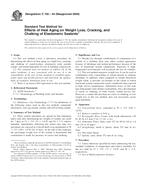We need your consent to use the individual data so that you can see information about your interests, among other things. Click "OK" to give your consent.
ASTM C792-04(2008)
Standard Test Method for Effects of Heat Aging on Weight Loss, Cracking, and Chalking of Elastomeric Sealants
STANDARD published on 1.5.2008
The information about the standard:
Designation standards: ASTM C792-04(2008)
Note: WITHDRAWN
Publication date standards: 1.5.2008
SKU: NS-15086
The number of pages: 3
Approximate weight : 9 g (0.02 lbs)
Country: American technical standard
Category: Technical standards ASTM
Annotation of standard text ASTM C792-04(2008) :
Keywords:
chalking, compound, cracking, elastomeric sealants, heat aging, non-sag sealants, self-leveling sealant, weight loss, Accelerated aging/testing--elastomeric sealants, Appearance of materials, Chalking, Cracking--sealants, Elastomeric seals/sealants, Heat aging, Joint seals/sealants, Nonsag joint sealants, Self-leveling joint sealants, Weight loss, ICS Number Code 83.060 (Rubber), 91.100.50 (Binders. Sealing materials)
Additional information
| Significance and Use | ||
|
Weight loss through volatilization of components of a sealant in a building joint may affect sealant appearance because of shrinkage and sealant performance because of the loss of functional sealant components. Exposure to high-temperature environments will accelerate the loss of volatiles. This test method measures weight loss. It can be used in combination with a knowledge of sealant density to estimate shrinkage. In addition, when compared to sealant theoretical weight solids, it provides an estimate of the extent to which functional sealant components can be volatilized when exposed to high service temperatures. Substantial losses of this type may help predict early failures in durability. Also, development of cracks or chalking, or both, lessens sealant service life. However, a sealant that develops no cracks or chalking, or low weight loss in this test method, does not necessarily assure good durability. |
||
| 1. Scope | ||
|
1.1 This test method covers a laboratory procedure for determining the effects of heat aging on weight loss, cracking, and chalking of cured-in-place elastomeric joint sealants (single- and multicomponent) for use in building construction. 1.2 This standard does not purport to address all of the safety problems, if any, associated with its use. It is the responsibility of the user of this standard to establish appropriate safety and health practices and determine the applicability of regulatory limitations prior to use. 1.3 There is no known ISO equivalent to this test method. |
||
| 2. Referenced Documents | ||
|
We recommend:
Technical standards updating
Do you want to make sure you use only the valid technical standards?
We can offer you a solution which will provide you a monthly overview concerning the updating of standards which you use.
Would you like to know more? Look at this page.




 Cookies
Cookies
